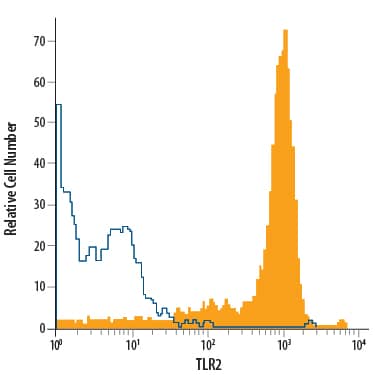Human TLR2 APC-conjugated Antibody
R&D Systems, part of Bio-Techne | Catalog # FAB2616A


Key Product Details
Species Reactivity
Applications
Label
Antibody Source
Product Specifications
Immunogen
Accession # O60603
Specificity
Clonality
Host
Isotype
Scientific Data Images for Human TLR2 APC-conjugated Antibody
Detection of TLR2 in Human Monocytes by Flow Cytometry.
Human peripheral blood monocytes were stained with Mouse Anti-Human TLR2 APC-conjugated Monoclonal Antibody (Catalog # FAB2616A, filled histogram) or isotype control antibody (Catalog # IC0041A, open histogram). View our protocol for Staining Membrane-associated Proteins.Applications for Human TLR2 APC-conjugated Antibody
Flow Cytometry
Sample: Human peripheral blood monocytes
Formulation, Preparation, and Storage
Purification
Formulation
Shipping
Stability & Storage
- 12 months from date of receipt, 2 to 8 °C as supplied.
Background: TLR2
Human toll-like receptor (TLR) family includes ten members that activate the innate immune response via an ability to recognize molecular structures found in a variety of microbial pathogens (1‑3). All TLR family members are type I transmembrane proteins with a large number of extracellular leucine-rich repeats (LRRs) and a cytoplasmic Toll/IL-1 receptor (TIR) domain. Human TLR2 is synthesized as a 784 amino acid (aa) precursor (2) that contains a signal sequence (aa 1-18), an extracellular domain (aa 19-588) with approximately 20 LRRs, a transmembrane segment (aa 589-609), and a cytoplasmic TIR domain (aa 610-784). The receptor is expressed on a number of cell types including monocytes, dendritic cells, neutrophils, B cells endothelial cells, and hepatocytes (1, 2, 4). TLR2 functions as part of a heterodimeric complex with either TLR1 or TLR6, and possibly other co-receptors (1). These complexes recognize lipoproteins and glycolipids from gram-positive and gram-negative bacteria as well as mycoplasma and yeast. TLR2/TLR1 heterodimers bind triacylated lipopeptides, while the TLR2/TLR6 heterodimer preferentially recognizes diacylated lipopeptides (5). Upon ligand recognition, TLR2 delivers an activating signal via the associated adapter molecules, MyD88 and TIRAP (1, 6). TLR2 signaling results in dendritic cell maturation characterized by increased surface expression of class II MHC and the T cell costimulators, CD80 and CD86 (1, 2). Activation via TLR2 also results in production of a number of pro-inflammatory cytokines including TNF-alpha, IL-2, IL-6, IL-12, and MIP-2 (1-3).
References
- Wetzler, L. (2003) Vaccine 21:S2/55.
- Kirschning, C. and R. Schumann (2002) Curr. Top. microbiol. Immunol. 270:121.
- Netea, M. et al. (2004) J. Leukoc. Biol. 75:749.
- Flo, T. et al. (2001) J. Leukoc. Biol. 69:474.
- Akira, S. (2003) Curr. Opin. Immunol. 15:5.
- Yamamoto, M. et al. (2002) Nature 420:324.
Long Name
Alternate Names
Gene Symbol
UniProt
Additional TLR2 Products
Product Documents for Human TLR2 APC-conjugated Antibody
Product Specific Notices for Human TLR2 APC-conjugated Antibody
For research use only